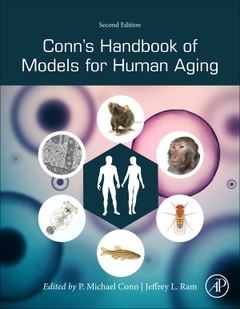Conn's Handbook of Models for Human Aging (2nd Ed.)
Coordonnateurs : Ram Jeffrey L., Conn P. Michael

Conn's Handbook of Models for Human Aging, Second Edition, presents key aspects of biology, nutrition, factors affecting lifespan, methods of age determination, use in research and the disadvantages/advantages of use. Using a multidisciplinary approach, this updated edition is designed as the only comprehensive, current work that covers the diversity in aging models. Chapters on comparative models explore age-related diseases, including Alzheimer's, joint disease, cataracts, cancer and obesity. Also included are new tricks and approaches not available in primary publications. This must-have handbook is an indispensable resource for researchers interested in the mechanisms of aging, gerontologists, health professionals, allied health practitioners and students.
I. Aging in Humans 1. Werner Syndrome as a model of human aging 2. Premature aging syndrome 3. Models, Definitions, and Criteria of Frailty 4. Immunological methods and the concept of inflamm-aging in the study of human aging 5. Vulnerability and Experiential Health in Old Age – a qualitative perspective 6. Body composition analysis in older adults 7. Using Computational Models to Study Aging 8. A framework for uncovering the roles of calories and macronutrients in health and aging 9. Female Reproductive Aging: From Consequences to Mechanisms, Markers, and Treatments 10. Adrenopause 11. What sets Iceland apart in understanding human aging
II. Animal models: Vertebrates 12. Reproductive Tract Lesions in Aged Chimpanzees 13. Age-related changes to the bony structure and musculature of the shoulder in a nonhuman primate model 14. The dog as a model for aging research 15. Dogs as a Spontaneous Model for Early Alzheimer's Disease 16. Determining cause of death and contributing causes of death in rodent aging studies 17. Rat Models of Cognitive Aging 18. Life Extension in Dwarf Mice 19. Extension of Lifespan in Laboratory Mice 20. Development and Validation of ECG analysis algorithm in mice 21. Old mouse lemur: behavior, cognition and neuropathology 22. Birds as models for the biology of aging and aging-related disease: an update 23. Telomeres and Telomerase in Birds: Measuring Health, Environmental Stress and Longevity 24. Zebrafish model for investigating the integrated control of reproduction 25. Modelling aging and age-associated pathology in zebrafish 26. The use of mature zebrafish (Danio rerio) as a model for human aging and disease 27. Piscine polemics; Small tropical fish species as models for aging research 28. The short-lived African turquoise killifish (Nothobranchius furzeri): a new model system for research on aging
III. Cellular models and invertebrates 29. A Budding Topic: Modeling Aging and Longevity in Yeast 30. The Budding and Fission Yeast Model Systems for Aging Biology: Rapid Advancement with New Technologies 31. Podospora anserina: a filamentous fungus with a strong mitochondrial etiology of aging 32. Invertebrates as model organisms for research on aging biology 33. Invertebrate models for the study of the effects of age on neurotransmitter release 34. Impact of Chronic Exercise on Invertebrate Functional Aging 35. The virtues and challenges of multidimensional analyses of whole brains during aging with single cell resolution 36. Rotifers as a Model for the Biology of Aging 37. The Potential of Comparative Biology to Reveal Mechanisms of Aging in Rotifers 38. Hydra, a model system for deciphering the mechanisms of aging and resistance to aging 39. Regeneration and Aging in The Tunicate Ciona intestinalis 40. Honeybee Workers as Models of Aging
IV. Disease models 41. Approaches to the Assessment of Frailty in Animal Models 42. Genotype and sex differences in life expectancy in transgenic AD mice 43. Animal models of vascular cognitive impairment and dementia 44. Alzheimer's Dementia Drug Discovery: Targeting Synaptic Glutamate Uptake 45. A Transgenic Monkey Model of Huntington’s Disease 46. Parkinson’s Disease in Humans and in Non-Human Primate Aging and Neurotoxin Models 47. Genetic Models of Parkinson’s Disease and Their Study in Non-Human Primates 48. Impact of the Aged Brain Environment on Gene Therapy for Parkinson’s Disease 49. Cell Therapy for Parkinson's Disease 50. Genetics of progeria and aging 51. Progeria mouse models 52. Models of Hypertension in Aging 53. Osteoporosis and Cardiovascular Disease in the Elderly 54. The role of the tumor microenvironment in pancreatic ductal adenocarcinoma and preclinical models to study it
V. Organ systems 55. Alopecia 56. Experimental Models of human skin aging 57. Muscle deconditioning and aging: experimental models 58. Models of Immune Aging 59. Sex and the aging immune system 60. Rodent Models of Ovarian Failure 61. Role of Sex and Aging in Mucosal Health 62. Leydig Cell Development and Aging in the Brown Norway Rat: Mechanisms and Consequences 63. Models of aging Kidney: Implications on kidney health and disease 64. Age-Associated Changes in Structure and Function of the Aging Human Lung 65. Glucose, insulin and brain aging 66. Pathology of brain aging and animal models of neurodegenerative diseases 67. Leptin and aging in animal models 68. Age-Related Changes to Bone Structure and Quality in Rodent Models
VI. Mechanisms 69. Dielectric properties of biological tissues; variation with age 70. Experimental Models of Tau Aggregation 71. Aging of Human Mesenchymal Stem Cells 72. Helicases and their relevance to aging 73. Genetics of human aging 74. Epigenetics of brain Aging 75. The Circadian Clock and the Aging Process 76. Super DNAging-New insights into DNA integrity, genome stability and telomeres in the oldest old 77. Model of Chaperones in Aging 78. Chaperone-mediated autophagy 79. Resveratrol in Aging and Age-Related Diseases 80. Resveratrol in experimental models and humans
Researchers interested in the mechanisms of aging, gerontologists, health professionals, and allied health professionals and students
- Combines both the methods of study for human aging and animal models
- Provides a historical overview and discussion of model availability, key methods and ethical issues
- Contains over 200 full color illustrations
Date de parution : 06-2018
Ouvrage de 1218 p.
21.4x27.6 cm
Épuisé



